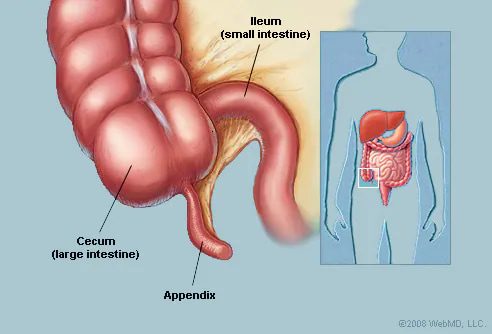Contents
The appendix
The appendix, also called the ileocecal appendix or vermiform appendage, is a small growth located in the large intestine. This element is best known to be the site of appendicitis, an inflammation requiring the removal of the appendix by surgery (appendectomy).
Anatomy: where is the appendix located?
Anatomical location
The appendix is a small growth of blind, first segment of the large intestine. The caecum follows the small intestine, to which it is connected by the ileocecal valve. The appendix is near this valve, hence its name ileo-cecal appendix.
Appendix positions
In general, it is said that the appendix is located at the bottom right of the navel. However, its location can vary, which can make it difficult to diagnose appendicitis. In the abdomen, this growth can take several positions :
- a sub-cecal poistion, horizontal and below the cecum;
- a mid-caecal position, slightly slanting downwards;
- a retro-cecal position, in height and at the back of the caecum.
Look
The appendix is presented as a hollow pocket. Its size is quite variable with a length between 2 and 12 centimeters and a diameter between 4 and 8 millimeters. The shape of this growth is often compared to that of a worm, hence its name of vermiform appendage.
Physiology: what is the appendix for?
To date, the role of the appendix is not fully understood. According to some researchers, this growth could be useless in the body. However, other hypotheses have been put forward by the researchers. According to their work, this growth could play a role in the body’s defense.
Role in immunity
According to some studies, the appendix could intervene in the immune system to strengthen the body’s defenses. Some scientific results suggest that immunoglobulins (antibodies) could be produced in the appendix. In 2007, researchers at Duke University Medical Center put forward another explanation. According to their results, the appendix would house a beneficial bacterial flora that would be kept in reserve to respond to severe indigestion. Nevertheless, the immune function of the appendix is still debated today within the scientific community.
Appendicitis: what is this inflammation due to?
Appendicitis
It corresponds to a inflammation of the appendix. Appendicitis is usually caused by a blockage in the appendix with feces or foreign objects. This obstruction can also be favored by an alteration of the intestinal lining or the development of a tumor at the base of the appendix. Conducive to microbial growth, this obstruction will cause an inflammatory reaction, which can manifest itself by various symptoms:
- abdominal pain near the navel, which usually gets worse over the hours;
- digestive disturbances, which can sometimes occur in the form of nausea, vomiting or constipation;
- a mild fever, which occurs in some cases.
Appendicitis: what is the treatment?
Appendicitis requires prompt medical attention because it can lead to serious complications such as peritonitis (inflammation of the peritoneum) or sepsis (generalized infection). Occurring mainly in people under the age of 30, this inflammation constitutes themedical emergency the most frequent.
Appendicectomie
The treatment of appendicitis requires emergency surgery: appendectomy. This consists of remove the appendix to prevent infection from developing in the body. Common, this operation represents on average 30% of surgical procedures performed on the abdomen in France. It can be done in two different ways:
- conventionally, by making an incision of a few centimeters near the navel, which allows access to the appendix;
- by laparoscopy or laparoscopy, by making three incisions of a few millimeters in the abdomen, which allows the introduction of a camera to guide the surgeon’s actions
Appendicitis: how to recognize it?
Appendicitis is difficult to diagnose. In case of doubt, it is recommended to seek urgent medical advice. An appendectomy is often recommended to rule out the risk of complications.
Physical examination
The diagnosis of appendicitis begins with an examination of the perceived symptoms.
Medical analysis
A blood test may be done to look for signs of an infection.
Medical imaging exams
To deepen the diagnosis, the appendix can be observed by medical imaging techniques such as abdominal CT scan or abdominopelvic MRI.
Appendix: what does science say?
Research on the appendix is all the more difficult as this growth is not very present in other mammals. Although several hypotheses are put forward, the exact role of the appendix remains unknown.










